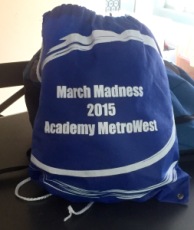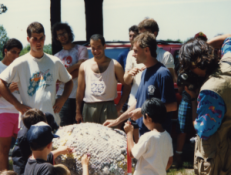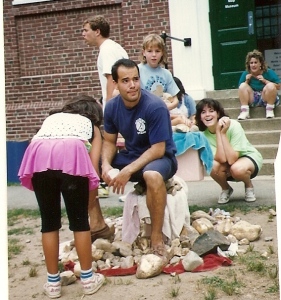Great Moments in Hype

Every March, the staff and kids here at Academy MetroWest take part in one of our favorite annual rituals – March Madness. No, we do not have our kids fill out brackets and bet on the NCAA basketball tournament. Although I’m sure we’d have some interesting picks if we did that, in our program, March Madness takes on a different connotation.
Throughout the school year, Academy MetroWest runs small, gym-based groups. The groups are aimed at helping children change the way they view themselves and interact with others. Activities center on cooperative, non-competitive games and are structured to emphasize the idea to children that, as a member of a group, their responsibilities extend beyond looking out for their own immediate self-interest. They need to be aware of their teammates’ needs and be able to take some initiative to help them. In March, most groups get the same choice of 8 different activities. What the 8 activities have in common, other than their cooperative structure, is that they all afford groups the opportunity to earn points. At the end of the month, we pool the points that each group earns and if we collectively reach our goal of 100,000 points everyone wins a prize. Usually that prize is a candy bar and some small goodie (a water bottle, sunglasses, small backpack, etc…). We’ve been doing it for about 10 years now and it’s something that our staff and group members look forward to every year. The kids have won their prize every year but somehow, even multi-year veterans of March Madness don’t usually catch on that it might just be fixed.

Some Academy MetroWest participants modeling their March Madness 2013 swag ( L ) and last year’s grand prize.
March Madness, like some other ideas we’ve had over the years, relies upon “presentation” (trans: hype) as much as substance. We’ve found that, presented with enough enthusiasm and creativity, kids will throw themselves fully into just about any activity. I have some modest examples here.
The first 2 great moments in hype I witnessed took place during the summer of 1991 at Camp Academy.
Camp Academy is the dearly departed, large, recreational day camp that used to be affiliated with our “parent” organization, The Academy of Physical and Social Development. It had about 200 kids enrolled in it and although it wasn’t structured as a therapeutic camp, it used the same cooperative approach to recreation that we use today. Before camp started that year, Stew Pruslin, a long time counselor and current member of our staff, approached the director and told him that he wanted to try to build the world’s largest lint ball that summer at camp. Stew used to run the end of the day assembly and he figured that if he presented it as an all-camp attempt to get into the Guinness Book of World Records, it would be a fun, silly thing to do. Well, he was right. At the end of each day, with the whole camp assembled for dismissal, Stew would start off each meeting by commanding in a loud, dramatic voice “Groups 1-3, BRING ME YOUR LINT!!,” whereupon a giddy group of kids would run up to Stew with the crop they had harvested from their dryer, pocket, belly button, or anywhere else lint could be found. He’d continue through all of the groups each day and by the end of the summer, as you can see from the photo, we had a very respectable ball of lint. Word of the lint ball traveled far and wide. We were in the newspapers, as well as on the radio and tv in areas as far apart as Concord, NH to Washington, DC. My own contribution to the lint ball endeavor, was the theme song (All You Need is Lint…set to a possibly recognizable tune). Unfortunately, we were not accepted into the Guinness Book. They said it was too specialized or something. Their loss.
All You Need is Lint – The lint ball is prepared and displayed for our campers and the media in 1991.

 That same summer, we played host to another great moment in hype. Every Friday, we did a different special event. We were growing a little tired of one of our events and decided to do something different. All week long, we put up some mysterious signs around the campus. Each sign was printed with
That same summer, we played host to another great moment in hype. Every Friday, we did a different special event. We were growing a little tired of one of our events and decided to do something different. All week long, we put up some mysterious signs around the campus. Each sign was printed with  the cryptic message “Fred is Coming.” By midweek, there was a noticeable buzz among the campers who were all wondering who this mysterious Fred could be. On Friday morning, we told everybody that Fred was going to be revealed at an assembly after lunch. Well, at the assembly, we brought out Fred, veiled in some lost and found towels. After a big build up, we dramatically unveiled Fred, a toilet that we had picked up from a local junkyard. We made up a story that Fred was a God-like figure who demanded tribute and it was up to the campers to provide it. Earlier in the day, the other directors and I had spray painted about 300 rocks metallic gold. So, for an hour or so, our 200 campers had the times of their lives searching for rocks to put in a toilet.
the cryptic message “Fred is Coming.” By midweek, there was a noticeable buzz among the campers who were all wondering who this mysterious Fred could be. On Friday morning, we told everybody that Fred was going to be revealed at an assembly after lunch. Well, at the assembly, we brought out Fred, veiled in some lost and found towels. After a big build up, we dramatically unveiled Fred, a toilet that we had picked up from a local junkyard. We made up a story that Fred was a God-like figure who demanded tribute and it was up to the campers to provide it. Earlier in the day, the other directors and I had spray painted about 300 rocks metallic gold. So, for an hour or so, our 200 campers had the times of their lives searching for rocks to put in a toilet.

In 1991, Camp Academy proved that all you need for a fun afternoon is a toilet, a bunch of rocks, and a sense of humor!
Fast forward to the late 90s. By this time, Academy MetroWest was operating. and we were in the midst of our summer program, Creative Adventures, This next great moment in hype was my partner Gary Steinberg’s big idea. I was skeptical. Gary was convinced it would work and, as much as it pains me to do so, I must admit that I was very very wrong. Gary’s brainstorm was the International Small Camp Olympics. We told our campers that Creative Adventures had joined an international consortium of small camps who were all participating in these games. All the camps would do the same activities and would periodically call in to headquarters to get an update on scores. So, after every activity, our campers and staff members would gather in the meeting area as Gary “called in” to HQ, using one of the gargantuan cell phones from that era. He’d report our results and to get the results from other camps around the world (The only camp I remember by name was “Camp Kangaroo” from Australia but I recall there being some camp from somewhere in Scandinavia as well). In the morning, we were not doing well. We’d be down near the bottom of the list after every event. Of course, we started to make our run in the afternoon and when the final results were announced, we won by a very close margin. The kids bought it – hook, line, and sinker – and were ecstatic. No one caught on that no one was on the other end of the line for all of Gary’s phone updates and no one figured it out that there was no such thing as Camp Kangaroo.

I’m sharing these stories to illustrate a few points. The first of them is that kids can be incredibly gullible sometimes. I’m sorry but it’s true.
The other points are a bit more constructive. For one thing, in the world of kids’ activities, it’s important to remember that presentation is everything. If we had introduced Fred by telling everyone “Today, kids, you’re all going to search the campus for a bunch of rocks and put them in a toilet,” it would not have gone over well at all. Presented with enthusiasm, the message that we’re going to search for gold nuggets to pay tribute to a God-like toilet….that’s another story. Hype works. When presented with some enthusiasm and creativity, it’s possible to get kids invested in lots of different activities that might otherwise seem very unexceptional. When kids see adults feeling enthused about something, it’s contagious and they usually buy right into it.
The other point I want to make is that these events all of something important in common. That is, they are all examples of kids having fun, working together as a team, and getting excited by working collaboratively. Even among kids who don’t normally do that very well or very willingly, when it’s presented with a little enthusiasm and a lot of craziness, they can do it.